Tech Report
Sanitary mixing in multi-agitator systems
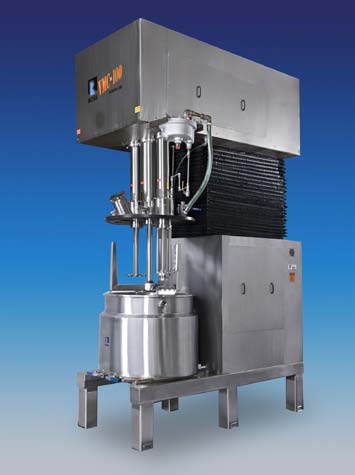
Technology Brief
Multi-shaft mixers are versatile systems used in the production of food, beverage, pharmaceutical and medical products. This bulletin discusses a few equipment features commonly supplied on multi-shaft mixers intended for sanitary applications.
Multi-shaft specialty mixers
Mixing is an integral part of food, beverage, dairy and pharmaceutical production. Within these industries, one of the most common specialty mixing systems in operation are multi-shaft mixers. These devices consist of a number of agitators working in tandem; for example, a low-speed anchor agitator producing bulk flow while a saw-tooth disperser blade turns at high speed to wet-out and disperse powders. Multi-shaft mixers are extremely versatile in terms of viscosity range (some models can handle up to ~1 million cP), shear levels and operating conditions (i.e. vacuum, heating/cooling, gas purging, etc.).
Safe and sanitary processing
In order to safely transform raw materials into finished product, any mixing system must meet the minimum requirements for sanitary processing. These requirements do vary from one market, product category or application to another. Nonetheless, any plant complying with Good Manufacturing Practice (GMP) guidelines can consider the following general suggestions on mixer selection. In addition to these items, more specific requirements or custom mixer features must be discussed with your mixer supplier.
Recommended mixer features
- Top-entering agitators. Unlike counter-rotating mixers with bottom-entering agitators, multi-shaft mixers offer better protection against contamination because there are no agitator seals submerged in the product zone.
- Gas-purged shaft seals. Double mechanical seals lubricated with a compatible seal barrier fluid are typically chosen for sanitary applications. For highly sensitive formulations, dry-running gas-purged sealing arrangements can be supplied.
- CIP rotary spray nozzles. Multi-shaft mixers can be cleaned in place by spraying cleaning solution via rotating nozzles strategically installed on the mixer cover.
- Powder induction assembly. When dealing with solid raw materials that tend to dust, consider sub-surface powder induction. This can be accomplished in a multi-shaft mixer equipped with a rotor/stator component. The Solids/Liquid Injection Manifold (SLIM) System available on Ross High Shear Mixers utilizes a specially modified rotor/stator assembly. The ported rotor generates an intense vacuum which draws solids right into the high shear zone of the mix chamber, where they are dispersed instantly into the liquid. To minimize dusting, operators can simply draw powders straight from the bulk container. The SLIM is also very effective in preventing the formation of agglomerates or "fish eyes".
Multi-Shaft Mixer Sample Configurations
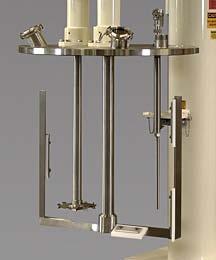
Dual-Shaft Mixer composed of a two-wing anchor with scrapers and a saw-tooth disperser. A temperature probe through the mixer cover is also shown.
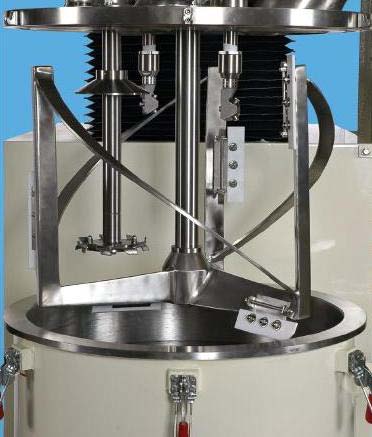
Dual-Shaft Mixer composed of a three-wing anchor with helical flights and scrapers, and a saw-tooth disperser with slinger. Two clean-in-place rotary spray nozzles are also shown.
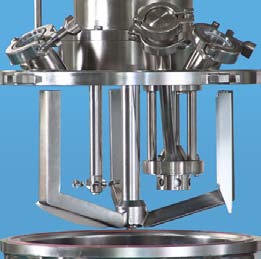
Triple-Shaft Mixer composed of a three-wing anchor with a toriconical bottom profile,a saw-tooth disperser and a rotor/stator with powder induction manifold.
Sample Application:Pectin-based Candy
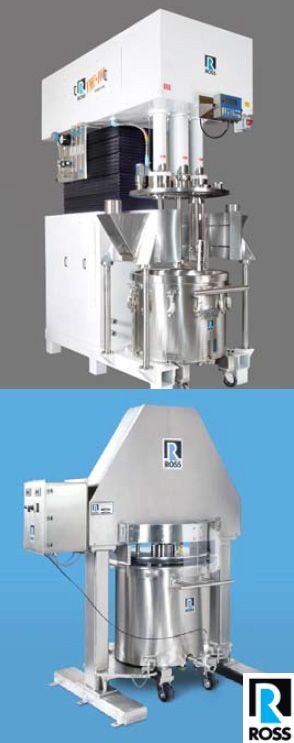
A Ross Triple-Shaft Mixer with Discharge System is installed at a facility making candy products. The mixing application is a highly viscous and sticky syrup which was previously manufactured using double arm paddle type mixers. The gum dispersion was inadequate which resulted in "fish eyes" and lumps visible in the finished product. Lab tests confirmed that the multi-shaft mixer can better disperse the gum powders and create a smoother, higher quality candy.
After the mixing cycle, the vessel is rolled to the discharge station for quick product transfer. As the discharge platen is lowered hydraulically into the vessel, a specially-fitted O-ring rides against the wall, literally wiping it clean. Cover guards are supplied on both the mixer and discharge system to help protect the batch from foreign materials in the environment.